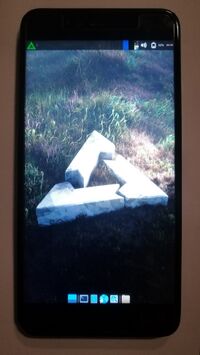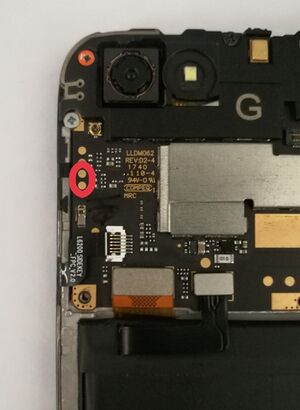Xiaomi Redmi Note 5A: Difference between revisions
No edit summary |
mNo edit summary |
||
| (23 intermediate revisions by 7 users not shown) | |||
| Line 1: | Line 1: | ||
{{Infobox device | {{Infobox device | ||
| manufacturer = Xiaomi | | manufacturer = Xiaomi | ||
| name = Redmi Note 5A | | name = Redmi Note 5A Prime | ||
| codename = xiaomi-ugg | | codename = xiaomi-ugg | ||
| image = File: | | image = File:xiaomi-ugg.jpg | ||
| imagecaption = | | imagecaption = Xiaomi Redmi Note 5A running XFCE4 | ||
| releaseyear = 2017 | | releaseyear = 2017 | ||
| originalsoftware = Android 7.1.2 | | originalsoftware = Android (MIUI) | ||
| originalversion = 7.1.2 (MIUI 11) | |||
| chipset = Qualcomm Snapdragon 435 (MSM8940) | | chipset = Qualcomm Snapdragon 435 (MSM8940) | ||
| cpu = 1.4 GHz Cortex-A53 | | cpu = 1.4 GHz Cortex-A53 | ||
| Line 14: | Line 15: | ||
| memory = 3GB | | memory = 3GB | ||
| architecture = aarch64 | | architecture = aarch64 | ||
| type = handset | |||
| status_usbnet = Y | | status_usbnet = Y | ||
| status_flashing = Y | | status_flashing = Y | ||
| status_touch = Y | | status_touch = Y | ||
| status_screen = | | status_screen = Y | ||
| status_wifi = | | status_wifi = Y | ||
| status_xwayland = | | status_xwayland = Y | ||
| status_fde = | | status_fde = Y | ||
| status_mainline = | | status_mainline = Y | ||
| status_battery = | | status_battery = Y | ||
| status_3d = | | status_3d = Y | ||
| status_audio = | | status_audio = Y | ||
| status_bluetooth = | | status_bluetooth = Y | ||
| status_camera = | | status_camera = N | ||
| status_gps = | | status_gps = N | ||
| status_mobiledata = | | status_mobiledata = N | ||
| status_sms = | | status_sdcard = Y | ||
| status_calls = | | status_emmc = Y | ||
| status = | | status_sms = N | ||
| status_otg = | | status_calls = N | ||
| status_nfc = | | status = | ||
| status_usba = | | status_otg = N | ||
| status_hdmidp = | | status_nfc = - | ||
| status_usba = - | |||
| status_hdmidp = - | |||
| status_keyboard = - | | status_keyboard = - | ||
| status_touchpad = | | status_touchpad = - | ||
| status_irtx = <!-- Infrared (IR) port works --> | | status_irtx = <!-- Infrared (IR) port works --> | ||
| status_trustzone = <!-- TrustZone works --> | | status_trustzone = <!-- TrustZone works --> | ||
| status_accel = | | status_accel = N | ||
| status_magnet = | | status_magnet = N | ||
| status_light = | | status_light = N | ||
| status_proximity = | | status_proximity = N | ||
| status_hall = | | status_hall = N | ||
| status_barometer = | | status_barometer = - | ||
| status_powersensor = | | status_powersensor = - | ||
| booting = yes | | booting = yes | ||
| n-android = ✔ | | n-android = ✔ | ||
| pmoskernel = 6.13 | |||
| pmoskernel = | | genericdevice = Generic MSM89x7 (qcom-msm89x7) | ||
| optionalgenericdevice = no | |||
| | }}{{Based on SoC|Qualcomm_Snapdragon_425/427/430/435_(MSM8917/MSM8920/MSM8937/MSM8940)|Snapdragon 435}} | ||
}} | |||
== Contributors == | == Contributors == | ||
| Line 66: | Line 63: | ||
== Users owning this device == | == Users owning this device == | ||
{{Device owners}} | {{Device owners}} | ||
== Installation == | |||
* Follow the [[Installation guide]] | |||
{{Note|'''Warning:''' Flashing [[lk2nd]] is '''required''', as it is a hard dependency. Without it the mainline kernel will not select the display panel (resulting in black screen on boot).}} | |||
<syntaxhighlight lang="shell-session"> | |||
$ pmbootstrap init # choose Vendor: qcom Device codename: msm89x7 | |||
$ pmbootstrap install | |||
$ pmbootstrap flasher flash_lk2nd | |||
$ pmbootstrap flasher flash_rootfs | |||
</syntaxhighlight> | |||
== How to enter flash mode == | == How to enter flash mode == | ||
While the phone is off, hold the Power | While the phone is off, hold the {{Button|Power}} + {{Button|Volume Down}} buttons together for a few seconds. | ||
== How to enter EDL mode == | |||
[https://www.thecustomdroid.com/qualcomm-edl-mode-guide/ EDL mode] (Emergency Download Mode) is a special mode in Qualcomm devices that allows, among other things, flashing firmware even when the phone is completely bricked. This might come useful in case something goes extremely wrong and the device won't even boot to fastboot. | |||
To boot into EDL, you must first disassemble the device in order to expose the motherboard points required. This phone is very easy to disassemble, you can search for videos on YouTube if necessary. Once you have removed the back case and disconnected the battery, find the points shown below on the motherboard: | |||
[[File:xiaomi-ugg_EDL_Testpoints.jpeg|300px|EDL testpoints on Redmi Note 5A motherboard (highlighted in red)]] | |||
These are the test points that enable EDL mode. With the battery disconnected, use a metal tweezer or a small wire to short these two points. While keeping them sorted, plug the phone to a computer. The device should show up as "Qualcomm HS-USB QDLoader 9008". You can now use [https://github.com/bkerler/edl this tool] to download firmware to your device. | |||
== See also == | == See also == | ||
| Line 81: | Line 95: | ||
* [https://redmine.replicant.us/projects/replicant/wiki/GalaxyS2I9100 Replicant wiki page] | * [https://redmine.replicant.us/projects/replicant/wiki/GalaxyS2I9100 Replicant wiki page] | ||
--> | --> | ||
* {{Device package|qcom-msm89x7}} | |||
* {{Kernel package|postmarketos-qcom-msm89x7}} | |||
* {{Device package| | |||
* {{Kernel package| | |||
Latest revision as of 01:09, 31 January 2025
| This device is supported as part of a generic port. Refer to Generic MSM89x7 (qcom-msm89x7) for installation instructions and more information. |
 Xiaomi Redmi Note 5A running XFCE4 | |
| Manufacturer | Xiaomi |
|---|---|
| Name | Redmi Note 5A Prime |
| Codename | xiaomi-ugg |
| Released | 2017 |
| Type | handset |
| Hardware | |
| Chipset | Qualcomm Snapdragon 435 (MSM8940) |
| CPU | 1.4 GHz Cortex-A53 |
| GPU | Adreno 505 |
| Display | 720x1280 IPS LCD |
| Storage | 32G |
| Memory | 3GB |
| Architecture | aarch64 |
| Software | |
| Original software | Android (MIUI) |
| Original version | 7.1.2 (MIUI 11) |
| postmarketOS | |
| Category | testing |
| Pre-built images | no |
| Mainline | yes |
| postmarketOS kernel | 6.13 |
| Generic port | Generic MSM89x7 (qcom-msm89x7) |
| Flashing |
Works |
|---|---|
| USB Networking |
Works |
| Internal storage |
Works |
| SD card |
Works |
| Battery |
Works |
| Screen |
Works |
| Touchscreen |
Works |
| Multimedia | |
| 3D Acceleration |
Works |
| Audio |
Works |
| Camera |
Broken |
| Camera Flash |
No data |
| IR TX |
No data |
| Connectivity | |
| WiFi |
Works |
| Bluetooth |
Works |
| GPS |
Broken |
| Modem | |
| Calls |
Broken |
| SMS |
Broken |
| Mobile data |
Broken |
| Miscellaneous | |
| FDE |
Works |
| USB OTG |
Broken |
| Sensors | |
| Accelerometer |
Broken |
| Magnetometer |
Broken |
| Ambient Light |
Broken |
| Proximity |
Broken |
| Hall Effect |
Broken |
| Haptics |
No data |
| This device is based on the Snapdragon 435. See the SoC page for common tips, guides and troubleshooting steps |
Contributors
- Flafflar
Users owning this device
- Bczeman
- Filip2cz (Notes: Prime version - this just added fingerprint reader, better camera and littlebit better cpu)
- Flafflar (Notes: Broken camera)
- Xiaoyu2006 (Notes: Broken display)
Installation
- Follow the Installation guide
| Warning: Flashing lk2nd is required, as it is a hard dependency. Without it the mainline kernel will not select the display panel (resulting in black screen on boot). |
$ pmbootstrap init # choose Vendor: qcom Device codename: msm89x7
$ pmbootstrap install
$ pmbootstrap flasher flash_lk2nd
$ pmbootstrap flasher flash_rootfs
How to enter flash mode
While the phone is off, hold the + buttons together for a few seconds.
How to enter EDL mode
EDL mode (Emergency Download Mode) is a special mode in Qualcomm devices that allows, among other things, flashing firmware even when the phone is completely bricked. This might come useful in case something goes extremely wrong and the device won't even boot to fastboot.
To boot into EDL, you must first disassemble the device in order to expose the motherboard points required. This phone is very easy to disassemble, you can search for videos on YouTube if necessary. Once you have removed the back case and disconnected the battery, find the points shown below on the motherboard:
These are the test points that enable EDL mode. With the battery disconnected, use a metal tweezer or a small wire to short these two points. While keeping them sorted, plug the phone to a computer. The device should show up as "Qualcomm HS-USB QDLoader 9008". You can now use this tool to download firmware to your device.
